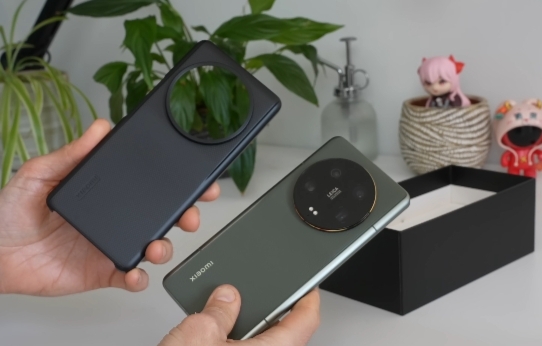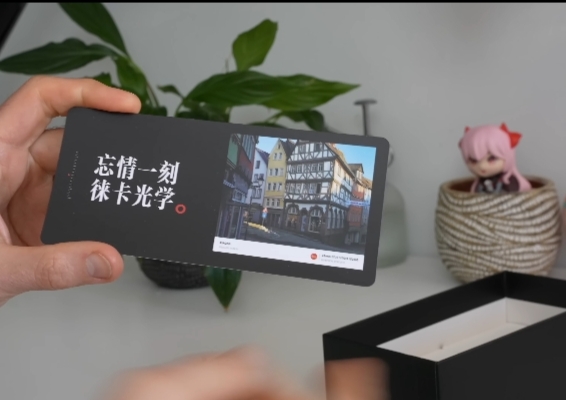The Xiaomi 13 Ultra boasts an overhauled camera with upgraded zoom tech and a variable aperture primary lens. You also have a snazzy new design and some of the other specs have been boosted.
Unboxing





In the box, you have a Xiaomi 13 Ultra, a small 90-watt fast charger, a USB Type-C cable, and a protective cover are also included. and in case you’re wondering, it’s a double-sided SIM tray with no room for micro SD memory cards.
Design


The Xiaomi 13 Ultra is a features a 6.73-inch screen, but the Godzilla title belongs to Samsung’s Galaxy S23 Ultra, which is the same size as the Xiaomi 13 Pro. The Ultra, on the other hand, features a thicker frame and a larger camera bump, similar to Samsung’s flagship. The screen has a little curved border, however it is far more subtle than prior flagships. In a gentle bend, the glass joins the metal frame. Thankfully, even when grasping the Xiaomi 13 Ultra tightly, I haven’t had any response concerns. This Ultra model, like the Xiaomi 13 Pro, is a large smartphone, weighing in at just under 230 grammes. If you’re worried about someone snatching your phone from your pocket, this is the device for you since if it was lifted out of your pants, you’d notice it right away, like someone attempting to steal Sisyphus’ boulder.
The Ultra, like the Pro, has Gorilla Glass Victus up front and a metal frame. However, flip it around and it couldn’t be more dissimilar. The Pro features a ceramic back in black or white, while the Ultra has seductive nanotech silicon leather with a soft touch textured finish that feels extremely luxurious against your palm. The textured surface does not span the entire width of the back end, but it covers a large section of it. The Xiaomi 13 Ultra is available in white or black, but the stunning olive green colour is a no-brainer. As was widely reported before to the debut, As you approach the camera bump, the back end rises. When you consider the camera bump, this is one girthy beast, a clear winner of the girth awards.

But I must admit that I adore Xiaomi’s design. I like how the camera bump looks, and the gold ring that surrounds it gives it a nice halo effect. I also love some of the finer elements that Samsung’s Galaxy S23 Ultra lacked. Like the Xiaomi 13 Pro, is water and dust resistant to IP68 standards. So you’re safe whether you drop it in the washbasin, bath or hot tub. Of course, I’m not sure what effect water and other liquids will have on that nice, gorgeous automobile in the back in the long run.
MiUI 14 and Features

The Xiaomi 13 Ultra’s software experience is quite similar to that of the Xiaomi 13 Pro. It’s Android 13 with MIUI 14 on top once more. However, my Ultra model was imported from China and did not come with any Google services pre-installed. This means I had to spend several hours obtaining an APK for the Play Store from APK Mirror and installing all of my other apps. There were still a lot of original Chinese apps on the phone, most of which I had no idea what they did.
Xiaomi’s phones are bloated with bloatware, but unlike last year’s Ultra model, Xiaomi has guaranteed a full global launch. So, fingers crossed that when it comes, it will come pre-installed with all of those Google services. After that, it was just like any other MIUI experience with features like the control centre and a useful video toolbox in media apps like YouTube.
It comes with a number of extra MIUI features, including as game mode and upscaling for low-quality content. It also includes three years of Android OS updates and five years of security updates, ensuring that it will not become obsolete in a matter of months, it has a storage capacity of up to 1TB, which can be expanded from 512GB. There’s no Micro SD card slot, but that shouldn’t be an issue unless you’re shooting a lot of 8K video or downloading a lot of huge games.
The in-display fingerprint sensor is only an optical sensor, not an ultrasonic one like the Galaxy S23 Ultra’s. However, it is responsive and has never let me down, even when my thumbs were wet. Face unlock is also quick and sensitive, although it is not as secure as the fingerprint sensor.
Display and Audio


There is no noticeable difference in display technology between the Xiaomi 13 Ultra and the Pro variant. It features a 6.73-inch OLED display with a Quad HD Plus panel that offers 3200 by 1440 pixel images. Because it is an OLED, the colours are vivid and lush, with superb contrast, making the visuals feel more immersive. It also supports Dolby Vision and HDR 10 Plus, and the display can scale from one Hertz to 120 hertz depending on the software. The sole difference between the ultra and the tiny Wii selfie cam aperture up top and display can be brightened to 2600 nits.
Also sports a robust and crisp stereo speaker arrangement, even at maximum volume. There is, however, no headphone jack and only Bluetooth 5.3 and LDAC support. Overall, the audio quality is excellent with high-resolution audio and Dolby Atmos support as well as graphics equaliser action.
Performance

In terms of performance, and unexpectedly, like pretty much every other flagship smartphone in 2023, Xiaomi has chosen a Qualcomm Snapdragon 8 Gen 2 processor to power this enormous behemoth. Yes, that is the same chipset that powers the Xiaomi 13 Pro. However, while sharing the same Snapdragon 8 N2 chipset, the Ultra has higher Geekbench 6 results. That’s most likely because my Ultra model has 16 GB of RAM against the 12 gigs in the Pro.

So, like the Pro, the Ultra model can literally blaze through any game out there, including Genshin Impact at 60 frames per second on the maximum graphic settings. Even when the action gets intense, and even after you’ve been gaming for a while, the frame rate remains consistent.
Even after an hour of gameplay, I noticed that the back ends were getting a touch hot, especially around the top end. That leathery ass was getting a little warm under my fingertips, but not to the point where it was bothering me, and certainly not enough to interfere with my job. That’s thanks to Xiaomi’s Liquid Cool Tech, which includes a huge Vapour chamber, a system that’s remarkably similar to the Pro.
As with the Pro, you have a terrific gaming mode that is jam-packed with brilliant features to help you get the best possible performance, capture the action, and do whatever you want while being attacked.
Battery Life
Regarding the battery, the Xiaomi 13 Ultra has a slightly larger capacity than the Pro, at 5,000 milliamp-hours. During the initial testing days, the battery life has been decent, offering about six hours of screen-on time before activating battery saver mode. However, extensive camera usage, like recording 4K videos or taking many photos, drains the battery faster. A comprehensive review will need further testing, but it seems that heavy users will be satisfied. In terms of charging, the Ultra is a bit slower than the Pro, with 90-watt broad charging compared to 120-watt wide charging. It’s better to charge it in the morning rather than at night. There’s also 50-watt wireless charging, but I couldn’t get it to work with my charging stand, perhaps due to its size. If you plan to use wireless charging, keep this in mind.
Camera Test

The Xiaomi 13 Ultra now boasts the same 50-megapixel primary camera as the Pro, equipped with Sony’s large one-inch IMX 989 sensor and hyper Optical Image Stabilisation to prevent handshakes from ruining your shot. However, the Ultra also introduces a dual aperture system, which is a notable difference. You can access the aperture photo option by pulling down the camera settings. Simply tap on it to choose between F 1.9 and F 4.0. Alternatively, if you prefer not to think about it, just leave it on auto.


This is a fantastic little feature. Obviously, you can go to F 1.9 for low-light images and switch between the two to acquire a variable depth of field. You can also experiment with various camera settings, such as the Leica style, in addition to altering the aperture. I prefer to leave this on authentic for a more natural look, but you may go to vibrant if you really want to increase those images and have more poppy colours.

And here are a couple of the sample images I took with the Xiaomi 13 Ultra during the previous few days. I discovered that it works beautifully at any time of day, whether you’re shooting into bright lights, dealing with stark contrast, or photographing more natural settings. The focus is quick to respond, and the shutter speed is very quick, so shooting live subjects on a phone is as painless as it can be. And, as previously stated, you can experiment with the depth of field to create some wonderful bokeh-style activity in your images, and you’ll always have that educated portrait mode to fall back on.


The night images seem to match up with those from Samsung’s Galaxy S23 Ultra. While the tones are slightly enhanced, there’s still plenty of detail even in low light. In my opinion, it’s on par with Galaxy S23 Ultra. However, I’ll be conducting a side-by-side comparison of the two next week.
It captures 12-megapixel photos using four-in-one pixel binning in auto mode, but you also have the option for a 50-megapixel high-resolution mode. Unlike the Xiaomi 13 Pro, the Ultra features two telephoto lenses. One has a 75mm focal length, using a Sony IMX 858 sensor with F/1.8 aperture and optical image stabilization. When focusing even closer, it switches to a 120mm telephoto lens with an IMX 898 sensor, F/3.0 aperture, and OIS. The zoom images are stunning, offering a staggering amount of detail even at 120 times magnification. However, at maximum zoom, things can become a bit blurry and distorted.
Additionally, there’s a 50-megapixel ultra-wide-angle camera, similar to the Pro model, perfect for fitting a lot into the frame or capturing dramatic shots. It’s not as focused on tones but delivers natural-feeling images. The device can record 8K resolution video at 24 FPS or 4K video at 60 FPS, and you can adjust the aperture when using the primary lens.
The sample videos shot are impressive, rivaling those from Samsung and Apple. The 8K footage is exceptional if you have the right equipment to enjoy it, but even at 4K resolution, the videos are detailed and vibrant. Stabilization is excellent, even in challenging conditions like windy environments. The phone performs well for nighttime video, producing clear images without excessive blurriness.
For selfies, the Xiaomi 13 Ultra’s capable 32-megapixel front-facing camera delivers good detail and balanced photos even in difficult lighting conditions. However, it’s limited to recording 1080p Full HD video, suitable for Skype and Zoom calls with clear video quality and excellent audio pickup.
Conclusion
I’ve been using the Xiaomi 13 Ultra as my primary smartphone for just over five days, and overall, I like it. It effortlessly completes every task, whether it be recording memories, taking pictures and videos, or streaming content. It also has a stylish appearance.
Stay soon for a thorough review; in the meantime, let me know what you all think?
It effortlessly completes every task, whether it be recording memories, taking pictures and videos, or streaming content. It also has a stylish appearance. Stay soon for a thorough review
- Design9.5
- MiUI 14 and features8
- Display and Audio9
- Performance9
- Battery Life8.5
- Camera9

